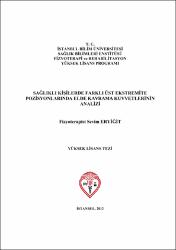| dc.contributor.advisor | Uğurlu, Ümit | en_US |
| dc.contributor.author | Eryiğit, Sevim | |
| dc.date.accessioned | 2014-06-18T06:53:40Z | |
| dc.date.available | 2014-06-18T06:53:40Z | |
| dc.date.issued | 2012-09-21 | |
| dc.date.submitted | 2012 | |
| dc.identifier.citation | Eryiğit, Sevim. (2012). Sağlıklı Kişilerde Farklı Üst Ekstremite Pozisyonlarında Elde Kavrama Kuvvetlerinin Analizi. Yayımlanmamış yüksek lisans tezi. İstanbul : İstanbul Bilim Üniversitesi, Sağlık Bilimleri Enstitüsü. | en_US |
| dc.identifier.uri | https://hdl.handle.net/11446/145 | en_US |
| dc.description | İstanbul Bilim Üniversitesi, Sağlık Bilimleri Enstitüsü, Fizyoterapi ve Rehabilitasyon Programı. | en_US |
| dc.description.abstract | Bu çalışmanın birincil amacı sağlıklı bireylerde farklı omuz pozisyonlarının kavrama kuvveti üzerindeki etkisini belirlemekti. Diğer amaçlar ise kişilerin mesleki ve antropometrik özellikleriyle kavrama kuvveti arasındaki bağıntının analiz edilmesiydi. Dört farklı meslek grubundan (öğretmen, işçi, hemşire, öğrenci), 20 ile 30 yaşları arasında toplam 113 kadın olgunun verileri analiz edildi. Kavrama kuvvetinin ölçülmesinde Jamar Dinamometresi kullanıldı. Ölçümler standart test pozisyonunun yanı sıra 0º, 45º, 90º ve 135°’lik omuz fleksiyon ve abdüksiyon açılarında alındı. Standart test pozisyonu dışındaki tüm omuz pozisyonlarında dirsek tam ekstansiyonda ve önkol semipronasyon pozisyonunda tutuldu. Olguların vücut ağırlığı, boy uzunluğu ve diğer antropometrik özellikleri ölçülerek kaydedildi. Tüm olgulardan elde edilen kavrama kuvveti ve antropometrik ölçüm değerleri dominant el referans alınarak ve gruplara ayrılarak sunuldu. Dominant ve nondominat eller arasında kuvvet farkı olup olmadığını belirlemek için bağımlı grup t-testi yapıldı. Antropometrik ölçümler ile kavrama kuvveti arasındaki ilişkinin kuvvetini belirlemek için Pearson bağıntı analizi yapıldı. Kavrama kuvvetinin belirlenmesinde etkisi olan faktörleri belirlemek için basamaklı çoklu regresyon analizi testi kullanıldı. Omuz pozisyonunun ve mesleklerin kavrama kuvveti üzerindeki etkisini belirlemek için tekrarlı ölçümler ANOVA analizi kullanıldı. Çalışmanın sonucunda tüm grupta ve her bir meslek grubunda farklı omuz pozisyonlarındaki kavrama kuvvetleri arasında anlamlı bir fark olmadığı tespit edildi. Tüm olgu grubunda kavrama kuvvetinin dominant elde, nondominant ele kıyasla yaklaşık %10 daha fazla olduğu bulundu. Aynı omuz açılarındaki fleksiyon ve abdüksiyon pozisyonlarında kavrama kuvvetleri arasında anlamlı bir fark olmadığı görüldü (p˃0,01). Tüm grupta, kavrama kuvveti ile antropometrik ölçüm değerleri arasındaki bağıntının pozitif yönde ve orta derecede kuvvete sahip olduğu belirlendi. Antropometrik ölçümler arasında en fazla el genişliğinin kavrama kuvveti düzeyini etkilediği görüldü (r=0,333; p˂0,01). Çalışma sonucunda kişinin maksimum kavrama kuvvetinin omuz pozisyonundan etkilenmediği ve farklı iş yüküne sahip meslek grupları arasında da değişmediği görüldü | en_US |
| dc.description.abstract | The primary aim of this study was to determine the effect of various shoulder positions on grip strength. The other aims were to analyse the correlation between grip strength and occupational and anthropometric characteristics of the people. The data obtained from 113 females aged 20-30 years and employed in four different occupations (teacher, worker, nurse and student) were analysed. Jamar Hydraulic Dynamometer was used for grip strength measurements. Besides the assessment in standard test position, the grip strength was also measured in shoulder flexion and abduction at 0º, 45º, 90º and 135°. In all positions of the shoulder, elbow was positioned in full extension while forearm was positioned in semipronation. Body weight, height and other anthropometric characteristics of the study subjects were measured and recorded. The grip strength results and anthropometric measures of study subjects were presented in groups and dominant hand was used as a reference. Paired Samples t Test was used in order to find if there is a difference in grip strength between dominant and non dominant hands. Pearson correlation analysis was used to determine the significance of relationship between anthropometric measurements and grip strength. In order to find the factors having effects grip strength, Stepwise Multiple Regression analysis was used. For evaluation the effect of shoulder position and occupations on grip strength, Repeated Measures ANOVA was utilized. In result, a significant difference for grip strength in different shoulder positions was not found in all groups and also for each occupation. For all the study subjects, the grip strength was found approximately 10% more in the dominant hand comparing to nondominant hand. A significant difference was not found between grip strengths in shoulder flexion and abduction at the same range of motions (p˃0,01). The correlation between grip strength and anthropometrics was found as positive. Hand width appeared as the most effective factor for the level of grip strength (r=0,333; p˂0,01). In conclusion, the maximum grip strength was found to be not affected from shoulder position and, this finding was also valid for the occupations having different workloads. | en_US |
| dc.language.iso | tur | en_US |
| dc.publisher | İstanbul Bilim Üniversitesi, Sağlık Bilimleri Enstitüsü. | en_US |
| dc.rights | info:eu-repo/semantics/openAccess | en_US |
| dc.subject | el kavrama kuvveti | en_US |
| dc.subject | omuz pozisyonları | en_US |
| dc.subject | meslek grupları | en_US |
| dc.subject | fleksiyon | en_US |
| dc.subject | abdüksiyon | en_US |
| dc.subject | hand grip strength | en_US |
| dc.subject | shoulder pozisitions | en_US |
| dc.subject | occupations grups, | en_US |
| dc.subject | flexion | en_US |
| dc.subject | abduction | en_US |
| dc.title | Sağlıklı kişilerde farklı üst ekstremite pozisyonlarında elde kavrama kuvvetlerinin analizi | en_US |
| dc.title.alternative | The analysing of hand grip strength of healthy people in different positions of upper extremities | en_US |
| dc.type | masterThesis | en_US |
| dc.department | DBÜ, Sağlık Bilimleri Enstitüsü, Fizyoloji Ana Bilim Dalı | en_US |
| dc.relation.publicationcategory | Tez | en_US |
| dc.identifier.yoktezid | 420056 | en_US |


















